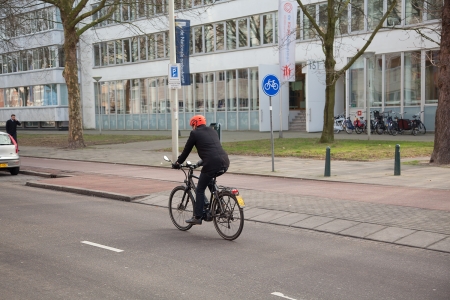The speed of pedelec and speed pedelec riders varies, but is generally higher than that of conventional cyclists [34] [35] [36]. Dutch research among 46 commuters (aged 25-56) showed an average speed of 21.0 km/h for pedelecs and 28.8 km/h for speed pedelecs, compared to 17.6 km/h for conventional bicycles; the three cyclist groups all cycled faster outside than within the urban area (Table 1, [30]). A different study in which older cyclists (65-69) also participated, showed that, on average, they also cycled faster on pedelecs than on conventional bicycles: depending on the situation, they cycled 1.7 to 3.7 km/h faster on pedelecs than on conventional bicycles [35].

Table 1. Average speed (km/h) of commuters on conventional bicycles, pedelecs, and speed pedelecs (at that time still categorised as light mopeds) [30]
Although pedelecs and speed pedelecs have pedal assistance up to 25 and 45 km/h respectively, Table 1 shows that the actual average speed is clearly much lower. Particularly for speed pedelecs, the difference is considerable. Their cruising speed of 32-37 km/h (depending on location), defined as the speed when sharp curves and large intersections are absent [37] or the speed that is maintained most often or most of the time [38] [39], is also far below the maximum of 45 km/h.
The 2017 legal changes concerning speed pedelecs (see the questionWhat rules apply to pedelecs and speed pedelecs?) seem to have had little effect on the average speed of speed pedelec riders. In the studies carried out when speed pedelecs were still categorised as light mopeds – allowed a maximum speed of 25 km/h and bicycle track use being mandatory [30] [37] – the average speeds that were measured were similar to the speeds after the legal changes. After these legal changes the maximum speed allowed for speed pedelecs increased, depending on the position on the road, to 30 km/h on a bicycle/moped track within the urban area, 40 km/h on a bicycle/moped track outside the urban area, or 45 km on the carriageway [30].
Particularly pedelecs are easy to tune up, enabling pedal assistance at higher speeds. It looks as if this regularly happens, but hard figures are missing. Tuned-up pedelecs were indeed found in an in-depth SWOV study of speed pedelec crashes [29]. The Dutch Fietsberaad [40] reports data from Germany where an estimated one in three pedelecs is tuned up. In Belgium a large number of bicycle dealers seems willing to tune up pedelecs [40]. BOVAG [41] and the Dutch ANWB [42] warn cyclists that the pedelec frame, brakes and technology are not designed to support such high speeds. Moreover, it is a criminal offence to use a tuned-up pedelec on public roads [42].
